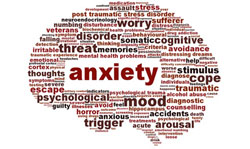 In an earlier blog article, I discussed the nature of anxiety, presenting some basic information as introductory background for this article about specific anxiety disorders.
In an earlier blog article, I discussed the nature of anxiety, presenting some basic information as introductory background for this article about specific anxiety disorders.
Before discussing the specific anxiety disorders, it should first be understood that the way anxiety symptoms are experienced differs, falling into three general patterns.
Unfocussed Anxiety
Here, anxiety symptoms are not connected with any recognizable stimulus to trigger them. Unfocussed anxiety, depending on the particular disorder experienced, may come as if out of nowhere, or alternatively, may be experienced continuously.
Focused Anxiety
Here, the anxiety is associated with recognizable triggering stimuli or situations.
Compulsive Anxiety
Here, anxiety occurs in the absence of performing a particular thought or behavior requirement which, once complied with, alleviates anxiety (temporarily).
There are two types anxiety disorder characterized by unfocussed anxiety. Generalized Anxiety Disorder (GAD) and Panic Disorder. In Generalized Anxiety, one experiences continuous unfocussed anxiety symptoms that cannot be attributed to any particular source. Sometimes the anxiety experienced is described as “free floating,” leaving the sufferer with an impending sense of non-specific dread, unable to say what they fear might happen. Because of their pervasive fear of the unforeseen and unforeseeable, one may imagine how sufferers become crippled with the inability to make decisions or to enjoy life, even when things (“only seem to be . . . “) going well. When unfocussed anxiety is exhibited in discrete episodes or attacks, rather than continuously, this describes Panic Disorder.
Focused anxiety disorders include the phobias, which involve irrational an fear of a known stimulus, combined with avoidance of the situation or stimulus that triggers it. In a previous article on anxiety, fear was differentiated from anxiety on the basis of the stimulus being “known.” The apparent contradiction is resolved by understanding that while the trigger stimulus in a phobia is recognized, the basis for the irrationally extreme reaction to it remains mysterious. One former had an inordinate fear of spiders (i.e., “Arachophobia”). One rainy night while driving on the highway, she thought she saw a tiny spider dangling from her rear view mirror. Her response was to scream, close her eyes, let go of the steering wheel, and lock-up the brakes. She skidded to a spinning stop that could easily have been fatal. While the trigger stimulus was well recognized, the reason for her potentially catastrophic excessive reaction to a harmless spider begged for understanding and resolution.
Phobias are quite common, involving fears of specific objects such as particular animals, as illustrated above, or fear of situations such as of heights (Acrophobia), closed in spaces (Claustrophobia), leaving home (Agorophobia), or fear of certain social situations (Social Phobia). Depending on the nature of the fear stimulus and the extent of phobic avoidance, a phobia may pose minimal inconvenience in ones life, or it can drastically disrupt the ability to live a normal life. A phobia of sharks in someone living in-land, for example, is unlikely to often cause much bother. On the other hand, agoraphobia may be debilitating to the point that the individual becomes house-bound, unable even to venture out for needed treatment.
Post-Traumatic Stress can also be considered as a disorder characterized by focused anxiety. After surviving a traumatic experience, the sufferer develops anxiety symptoms associated with the trauma and stimulus triggers reminiscent of the traumatic situation.
Obsessive-Compulsive Disorder involves the feeling of having to engage in (often unwanted) repetitive thoughts, actions or rituals. These compulsions serve to relieve the unwanted obsessive ideas that plague the mind until the compulsion is performed. Only then is relief from anxiety granted, albeit, only temporarily. Ritualistic compulsions are many and varied, often involving cleaning or organizing rituals, the need to avoid stepping on cracks, ensuring one wears certain colors on particular days, etc. While it is very common to exhibit minor obsessions with their accompanying rituals, most people seem to know recognize someone in their sphere with a serious compulsions that overtake their life.
Individuals with well-developed anxiety disorders invariably recognize they have a problem. They often chide themselves for allowing “such a silly thing” to disrupt their lives as much as it does. Unfortunately for those who try so hard on their own without success, the solution to these difficulties often lies obscured by our psychological blind spots. If you, or someone you know, has been battling anxiety too long without improvement, they should seek professional assistance before more of life passes them by.